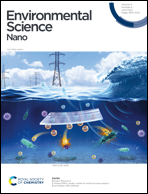Silicon reduces the uptake of cadmium in hydroponically grown rice seedlings: why nanoscale silica is more effective than silicate†
Abstract
Our previous study suggested that the application of silicon (Si) could reduce the uptake and accumulation of Cd in rice. However, the effects of different Si forms on the uptake and accumulation of Cd have not been investigated and the underlying mechanisms are not fully clear. Here, we investigated the potentially different effects of silica nanoparticles (Si NPs) and silicate on the uptake and transport of Cd in rice seedlings in a hydroponic system. The results suggested that the Si NPs-pretreated group had a higher Cd tolerance by improving the antioxidant activities of rice seedlings compared with the silicate-treated plants. Meanwhile, the addition of Si NPs could more effectively reduce Cd uptake and transport in the tissues of rice seedlings. At the subcellular level, the Si NPs-pretreated group showed a higher proportion of Cd in the cell wall fraction compared with the silicate-treated group. Furthermore, the pretreatment with Si NPs exhibited stronger inhibitory effects on the uptake of Cd in the root cell by increasing the mechanical force of the cell walls, as measured by atomic force microscopy. At the gene level, the addition of Si NPs showed relatively stronger effects on regulating the expression level of Cd-related genes compared with that of the silicate. This finding provides new insights and a foundation for Si-related application in Cd-contaminated paddy soil remediation.



 Please wait while we load your content...
Please wait while we load your content...